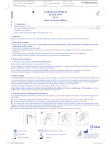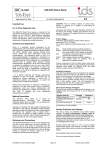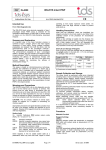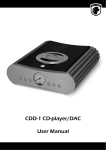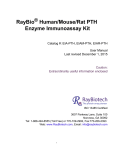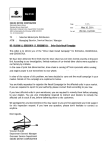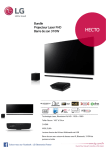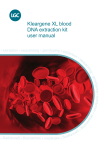Download Précautions d`utilisation du produit :
Transcript
REF IS-3200 Instructions for Use IDS-iSYS Intact PTH IN VITRO DIAGNOSTIC Intended Use For In Vitro Diagnostic Use The IDS-iSYS Intact PTH assay is intended for the quantitative determination of PTH in human serum or plasma on the IDS-iSYS Multi-Discipline Automated Analyser (Analyser). Results are to be used in conjunction with other clinical and laboratory data to assist the clinician. The main function of PTH is the regulation of serum ionized calcium levels. Measurement of circulating PTH levels is important in the differential diagnosis of hypercalcaemia and hypocalcaemia. Summary and Explanation Parathyroid hormone (PTH) is a polypeptide hormone of 84 amino acids secreted by the parathyroid glands. Synthesis of PTH is governed by direct negative feedback of ionised calcium on the parathyroid tissues (1). A fall in serum calcium stimulates PTH release, which acts on the kidneys to promote calcium reabsorption and 1,25dihydroxyvitamin D production. This stimulates bone resorption, restoring serum calcium levels to physiologically acceptable levels (2). PTH is rapidly metabolised in the liver and kidney (half-life of full-length 1-84 PTH is 2-4 minutes) to N- and Cterminal fragments (3). In healthy individuals however, PTH fragments are effectively cleared by the kidneys. Impaired renal function results in the accumulation of PTH fragments to very high levels (4). Measurement of circulating PTH is of particular value in the differential diagnosis of hypercalcaemia, improving the clinical discrimination between patients with hyperparathyroidism and those with hypercalcaemia of malignancy (HCM). Hyperparathyroidism may be secondary to intestinal malabsorption of calcium or vitamin D deficiency, and is a consistent feature of chronic kidney disease (CKD) (5). Elevated PTH levels are linked to adverse cardiovascular events in CKD (6). Grossly elevated levels of C-terminal PTH fragments can lead to misdiagnosis due to interference in immunoassays not specifically formulated to avoid this (2). Method Description The Intact PTH assay is based on chemiluminescence technology. Two polyclonal antibodies against human PTH are utilised. An antibody recognising the C-terminal region (amino acids 39-84) is used as the capture antibody. For detection, an acridinium conjugated antibody recognising the N-terminal region (amino acids 13-34) is used. In addition to full-length PTH (amino acids 1-84) the large PTH fragment (amino acids 7-84) will also be detected. Samples are incubated with both labelled antibodies for a period of time. Streptavidin coated magnetic particles are then added and following a further incubation step, the particles are “captured” using a magnet. After a washing step and addition of trigger reagents, the light emitted by the acridinium label is directly proportional to the concentration of PTH in the original sample. Warnings and Precautions The IDS-iSYS Intact PTH Assay is for in vitro diagnostic use only and is not for internal use in humans or animals. This product must be used strictly in accordance with the instructions set out in these Instructions for Use (IFU). IDS IS-3200PLv02, 2011-02-21, English Limited will not be held responsible for any loss or damage (except as required by statute), howsoever caused arising out of non-compliance with the instructions provided. CAUTION: This kit contains material of animal origin. Handle kit reagents as if capable of transmitting an infectious agent. Appropriate precautions and good laboratory practice must be used in the storage, handling and disposal of the kit reagents. Disposal of kit reagents should be in accordance with local regulations. Sodium Azide Xn. Harmful: Calibrators contain sodium azide (NaN 3 ) >0.1% (w/w) (<1%). R22 R52/53 S46 S36/37 S60 Wear suitable protective clothing and gloves. Harmful to aquatic organisms, may cause longterm adverse effects in the aquatic environment. If swallowed, seek medical advice immediately and show this container or label. Wear suitable protective clothing and gloves. This material and/or its container must be disposed of as hazardous waste. Handling Precautions Apart from the calibrators which are lyophilised, the reagents provided in the kit are ready to use. Refer to the calibrator section of the procedure for reconstitution methodology. Before a new cartridge is loaded onto the Analyser, the magnetic particle container requires mixing by the operator with a brisk rotation motion. This will resuspend the magnetic particles that have settled during shipment. It is very important to avoid any foam formation. Shelf Life and Storage of Reagents Prior to first use, store the cartridge and the calibrators in an upright position in the dark at 2 to 8 °C. Do not freeze the cartridge. Reagent shelf life Before opening at 2 - 8 °C Cartridge, after opening at 2 - 8 °C Calibrators, after reconstitution at -20 °C On board the Analyser (*) Cartridge Calibrators To the expiry date 28 days N/A N/A 14 days 21 days 2 hours (*) Continuous on board stability. Sample Collection and Storage The assay should be performed using serum (standard sampling tubes or tubes containing serum separating gel) or plasma (lithium heparin or potassium EDTA) samples. Samples should be separated as soon as possible after collection due to the labile nature of PTH. Store samples at -20 °C or below. Avoid repeated freezethaw of samples. Note: Improper handling and storage of samples may result on loss of assayable PTH. To minimise possible evaporation effects, samples, calibrators, and controls should be measured within 2 hours after being placed on the analyser. Before assay, make sure that samples, calibrators and controls are at room temperature (20 - 25 °C). Page 1/4 Device code : IS-3200 REF IS-3200 Instructions for Use Note: IDS-iSYS Intact PTH IN VITRO DIAGNOSTIC Some sample collection tubes that are commercially available might affect the results of testing in particular cases. It is recommended to follow the instructions of the tube manufacturer especially when processing samples in primary tubes. Procedure Materials Provided Reagent Cartridge MP Magnetic particles coated with streptavidin in a phosphate buffer containing sodium azide as preservative (<0.1%), 1 bottle, 2.7 mL. CONJ Anti-PTH labelled with an acridinium ester derivative, in buffer containing goat serum with sodium azide as preservative (<0.1%), 1 bottle, 7.25 mL. Ab-BIOT Anti-PTH labelled with biotin, in buffer containing bovine and goat proteins with sodium azide as preservative (<0.1%), 1 bottle, 13 mL. Calibrators CAL A CAL B A buffered porcine serum matrix containing PTH and sodium azide as preservative (<0.2%), 2 each of 2 concentration levels, 1 mL. Mini CD Contains IFU for IDS-iSYS reagents, control ranges and CRY files. Materials Required But Not Provided IDS-iSYS Multi-Discipline Automated Analyser : IS-310400 IDS-iSYS PTH Control Set: IS-3230, 6 x 1 mL each of level 1, 2, and 3. IDS-iSYS Cuvettes Cube: IS-CC100, box of 960 cuvettes. IDS-iSYS System Liquid: IS-CS100, 5 L container, ready to use. IDS-iSYS Wash Solution: IS-CW100, 10 L container, ready to use. IDS-iSYS Triggers Set A and B: IS-CT100, 2 x 250 mL per bottle, ready to use. IDS-iSYS Cartridge Check System: IS-6010, ready to use. IDS-iSYS Sample Cups (500 µL): IS-SC105. Assay Procedure Reagent Cartridge The reagents provided in the cartridge are ready to use. The analyser automatically performs the mixing of magnetic particles to maintain homogeneity. Before a new cartridge is loaded on board the analyser, mix the magnetic particles container by brisk rotation motion. Avoid foam formation. The barcode is read when the cartridge is loaded on the reagent tray. If the label cannot be read by the analyser barcode reader, a manual procedure exists to enter the barcode data (see the IDS-iSYS User Manual). Load the cartridge on the reagent tray and wait for at least 40 minutes before starting the assay. IS-3200PLv02, 2011-02-21, English If the cartridge is removed from the reagent tray, store the cartridge vertically at 2 - 8 °C in the dark. Calibrators The PTH calibrators are lyophilised. Reconstitute immediately before use. Add 1.0 mL of distilled or deionised water to each bottle. Replace the stopper. Leave for 20 minutes to reconstitute with occasional gentle vortexing. Invert calibrators gently before use. Pipette approximately 450 µL of calibrators into sample cups and place on the machine. Proceed according to the instructions of the IDS-iSYS User Manual. DO NOT return material to the calibrator vial. If calibrators are to be used more than once, they should be aliquotted and stored at -20 °C or lower within 15 minutes of reconstitution. When re-using frozen calibrators, thaw at room temperature and mix well. Ensure that calibrators are at room temperature before they are placed on the machine. Calibrators should be placed on the machine within 30 minutes of thawing. Aliquots should not be re-frozen. Analyser Calibration The two PTH calibrators are required to perform the adjustment of the master curve. The calibrators are supplied with the kit and calibrators from another lot must not be used. Note that to perform a master curve adjustment controls MUST be run at the same time as the calibrators. All data required for the calibration of the cartridge batch can be found on the mini CD. Use calibrator levels A and B to adjust the master curve to the reagents on board the Analyser. Check for the presence of a PTH cartridge on the reagent tray and the availability of the cartridge master curve in the database. If the data for the lot of calibrators is not available on board the analyser, load the data using the mini CD provided with the calibrator. Start the immunoassay calibration on the IDS-iSYS Analyser according to the IDS-iSYS User Manual. The calibration is carried out in triplicate. RLU CVs of >5% will result in a failed calibration. One replicate may be removed to meet the calibration requirements. As stated above, please note that controls must also be run. Verify and approve the calibration according to the calibration status displayed in the calibration windows and discard the calibrator from the sample tray after use. Calibration The IDS-iSYS Intact PTH assay has been standardized against in-house reference standards. Conversion Factor to International PTH Standard A conversion factor to the WHO International Standard for Parathyroid Hormone (NIBSC Reference 95/646) has been established. IDS-iSYS Intact PTH = 1.46 x WHO PTH Standard Calibration Frequency A new calibration is required: • Each time a new lot of cartridges is loaded on board • Each time a new lot of trigger or cuvettes is used • When the control values do not fall within the defined ranges Page 2/4 Device code : IS-3200 IDS-iSYS Intact PTH REF IS-3200 Instructions for Use • • IN VITRO DIAGNOSTIC When the calibration has expired After Analyser service. Verification of the calibration is automatic and managed by the Analyser. Quality Control Use the IDS-iSYS Intact PTH Control Set for quality control. To ensure validity of results at least three controls with varying levels of PTH should be measured. Other suitable control material can be used in addition to the IDS-iSYS Intact PTH Control Set. Controls should be tested at (or near) the beginning of every run containing patient samples and also during calibrations or according to local regulations. It is recommended that the controls be routinely run in duplicate. Laboratories should test controls at least once per shift. Refer to the IDS-iSYS Intact PTH Control Set IFU for preparation and handling instructions. Determination of Sample Intact PTH levels Process samples according to the IDS-iSYS User Manual. Calculation of Results The PTH concentration of each sample is calculated automatically. The display of the concentrations (screen or printed) is produced upon user request. The IDS-iSYS PTH Assay uses a 4-parameter logistic curve fit (4PL) to calculate the Intact PTH concentrations. 4. The hook effect was tested using concentrations of PTH up to 95,000 pg/mL. No hook effect was observed. Expected Values Each laboratory should determine ranges for their local population. The following range was determined using the IDS-iSYS Intact PTH Assay and is provided for information only. The 95% reference interval for the following group was calculated by a non-parametric method following the NCCLS guideline C28-A2, “How to Define and Determine Reference Intervals in the Clinical Laboratory”. All subjects had 25-OH Vitamin D levels of > 10 ng/mL. Normal Adults 11.5 – 78.4 pg/mL (n=243) Performance Data Representative performance data are shown. Results obtained at individual laboratories may vary. Sensitivity The limit of blank (LoB), limit of detection (LoD) and limit of quantitation (LoQ) were determined with guidance from CLSI EP17-A, “Protocols for Determination of Limits of Detection and Limits of Quantitation” using 100 blanks and 50 low level samples. LoB LoD LoQ Measurement Range (Reportable Range) The reportable range of the assay is 5-5000 pg/mL. Any value that reads below 5 pg/mL should be reported as “< 5 pg/mL”. Limitations of Use 1. As in the case of any diagnostic procedure, results must be interpreted in conjunction with the patient’s clinical presentation and other information available to the physician. 2. The performance characteristics of this assay have not been established in a paediatric population. 3. Precision Precision was evaluated in accordance with a modified protocol based on CLSI EP-5A2, “Evaluation of Precision Performance of Quantitative Measurement Methods”. Three serum controls were assayed using three lots of reagents in duplicate twice per day for 20 days on three instruments. The following substances do not interfere in the IDS-iSYS Intact PTH Assay when the concentrations presented in the following table are below the stated threshold. Potentially Interfering Agent Lipid Bilirubin Haemoglobin Biotin Red Blood Cells Human Calcitonin Cross-laps/CTX-1 Osteocalcin HAMA Rheumatoid Factor PTH (53-84) PTH (39-68) PTH (44-68) IS-3200PLv02, 2011-02-21, English Threshold Concentration 3000 mg/dL 20 mg/dL 250 mg/dL 300 nmol/L 0.4% 10,000 pg/mL 12 ng/mL 400 ng/mL 1000 ng/mL 2530 IU/mL 100,000 pg/mL 100,000 pg/mL 100,000 pg/mL 1.2 pg/mL 2.5 pg/mL < 5 pg/mL Concentration (pg/mL) n Within-run Total SD CV% SD CV% 13.3 80 0.6 4.4% 1.0 7.4% 21.0 80 1.3 6.3% 1.7 8.2% 29.0 80 1.1 3.7% 1.7 5.8% 41.1 80 1.1 2.6% 2.2 5.4% 192 80 4 2.3% 10 5.1% 223 80 2 1.1% 9 4.1% 740 80 7 1.1% 35 4.7% 1956 80 35 1.8% 87 4.4% 2599 80 59 1.9% 124 4.8% 3807 80 52 1.4% 191 5.0% Recovery Recovery was assessed by adding PTH (1-84) to samples prior to assay. Average recovery in EDTA plasma was 104%, average recovery in serum samples was 98%. Linearity Linearity was evaluated based on CLSI EP-6A, “Evaluation of the Linearity of Quantitative Measurement Procedures: A Statistical Approach”. Samples containing varying Page 3/4 Device code : IS-3200 REF IS-3200 Instructions for Use IDS-iSYS Intact PTH IN VITRO DIAGNOSTIC USA Immunodiagnostic Systems Inc. 8425 N. 90th Street, Suite 8, Scottsdale, AZ 85258 Tel.: 1 480.278.8333 • Fax: 1 480.836.7437 e-mail: [email protected] • www.idsplc.com Germany Immunodiagnostic Systems GmbH (IDS GmbH), Mainzer Landstrasse 49, 60329 Frankfurt am Main. Tel.: +49 69 3085-5025 • Fax: +49 69 3085-5125 e-mail: [email protected] • www.idsplc.com France Immunodiagnostic Systems (IDS), 153 Avenue D’Italie, 75013 Paris, France Tel.: (0)1 40 77 04 50 • Fax : (0)1 40 77 04 55 e-mail: [email protected] • www.idsplc.com Scandinavia Immunodiagnostic Systems Nordic a/s (IDS Nordic a/s), Marielundvej 30, 2. Sal, 2730 Herlev, Danmark Tel:+45 44 84 0091 e-mail: [email protected] • www.idsplc.com Belgium Immunodiagnostic Systems S.A., Rue E. Solvay 101, 4000 Liège, Belgium Tel.: +32 4 252 26 36, Fax : +32 4 252 51 96 e-mail: [email protected] • www.idsplc.com concentrations of PTH were assayed in duplicate. The resulting mean concentrations were compared to predicted concentrations. Samples were prepared by diluting a high patient sample with a low patient sample prior to assay. Four sets of samples covering the range of the assay were measured, giving a total of 76 measured dilutions. Average Observed/Expected Intact PTH values were 99%, with an r-squared of 1.00 defined by linear regression analysis. Method Comparison The IDS-iSYS Intact PTH Assay was compared against a recognized immunoassay for the quantitative determination of Intact PTH, following CLSI EP-9A2, “Method Comparison and Bias Estimation Using Patient Samples”. A total of 158 samples, selected to represent a wide range of PTH concentrations [5.7-4744 pg/mL], was assayed by each method. Linear regression analysis was performed on the comparative data: IDS-iSYS = 1.06 (x) -3.8 (95% CI of the slope and intercept were 1.06 to 1.07, and -8.9 to 1.3, respectively); correlation coefficient (r-squared) = 1.00. Specificity Analyte PTH (1-84) PTH (7-84) PTH (1-34) PTH (39-84) Cross-Reactivity 100% 60% 0.5% Not detectable Bibliography 1. 2. 3. 4. 5. 6. Potts JT. Parathyroid Hormone: Past and present. J Enocrinology (2005) 187: 311-325. Bringhurst FR. et al: Circulating forms of parathyroid hormone: Peeling back the onion. Clin Chemistry (2003) 49: 1973-1975. Komaba H. et al. Critical issues of PTH assays in CKD. Bone (2009) 45: 514-518. D’Amour P et al. Structure of non-(1-84) PTH fragments secreted by parathyroid glands in primary and secondary hyperparathyroidism. Kidney Int (2005) 68: 998-1007. Lamb EJ et al. Parathyroid hormone, kidney disease, evidence and guidelines. Ann Clin Biochem (2007) 44: 1-4. Meunier P. et al. Plasma PTH level and prevalent cardiovascular disease in CKD stages 3 and 4: An analysis from the kidney early evaluation program (KEEP). Am J Kid Dis (2009) 53 supp 4: S3-S10. Immunodiagnostic Systems Ltd (IDS Ltd), 10 Didcot Way, Boldon Business Park, Boldon, Tyne & Wear, NE35 9PD, England Tel.: +44 191 519 0660 • Fax: +44 191 519 0760 e-mail: [email protected] • www.idsplc.com Immunodiagnostic Systems UK Immunodiagnostic Systems Ltd (IDS Ltd), 10 Didcot Way, Boldon Business Park, Boldon, Tyne & Wear, NE35 9PD, England Tel.: +44 191 519 0660 • Fax: +44 191 519 0760 e-mail: [email protected] • www.idsplc.com IS-3200PLv02, 2011-02-21, English Page 4/4 Device code : IS-3200




